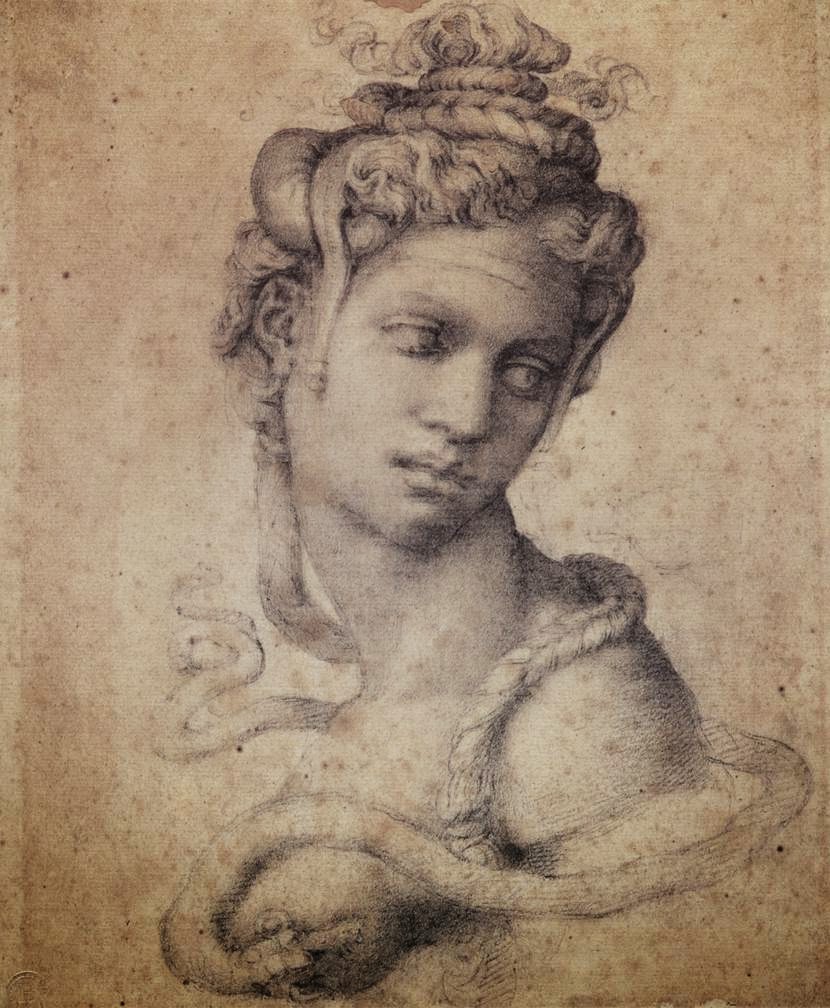A Michelangelo Appetizer
 |
| Cleopatra |
This has been quite a year for fans of Renaissance art in Japan, with all three of its giants — Leonardo da Vinci, Raphael, and now Michelangelo — featuring in exhibitions. While the da Vinci show was weak in content and the Raphael quite well stocked, the latest show "Michelangelo Buonarroti" at the National Museum of Western Art seems to fall somewhere in between.
There are a couple of sculptures, including Michelangelo's earliest known work, The Madonna of the Stairs (ca. 1490), and quite a few studies and sketches, some of which, such as Cleopatra (1535), are quite well developed, although still very far from being finished works. These are supplemented by various letters and architectural plans by the artist, as well as a selection of related works by other artists. Among these is a portrait of the great man himself, attributed to the mannerist painter Marcello Venusti, who is mainly remembered for having painted an impressive copy of Michelangelo’s fresco The Last Judgement (1537-41).
This show is also superior to the da Vinci exhibition because the contents are used more effectively to tell a cohesive story, namely the creation of what is probably the world's single greatest work of art, the series of interlinked frescoes that make up the ceiling of the Sistine Chapel in the Vatican.
The show's subtitle is "The Making of a Genius and the 500th Anniversary of the Sistine Chapel," a strong-enough story line even for Charlton Heston, who played the role of Michelangelo painting the famous chapel in the 1965 film The Agony and the Ecstasy.
The Sistine Chapel fresco was commissioned by the "warrior pope" Julius II and painted between 1508 and 1512, at a time when the Catholic Church was at the height of its power, influence and indeed arrogance. The Reformation was just around the corner.
 |
| The Madonna of the Stairs |
Obviously, Michelangelo's frescoes are not the sort of artwork that can be shipped around the world. If you really want to see them, you will have to visit Rome. This fact gives the whole exhibition something of the flavor of a travel advertisement, which, one suspects, may be part of the plan. But there is also enough here to give visitors a well-rounded, virtual experience.
There is a high definition movie, as well as large- and small-scale reproductions of the Sistine ceiling and The Last Judgment, which occupies a wall of the same chapel. But if art is about anything, it is about authenticity. No matter how skillful recreations are, there is always going to be something a little Disneyland-ish about them. There is no substitute for the actual works of the artist.
The Madonna of the Stairs, the first of the originals, is a beautiful relief sculpture, carved when the artist would have been 15 or 16. The skill already evident at such an age suggests that genius in this case was not so much made as born. The real story of the exhibition, then, is not how Michelangelo's genius developed, but instead how it came to focus its brilliance on the paintings of the Sistine Chapel.
From letters and architectural plans in his own hand, we start to get a sense of Michelangelo as an archetypal "Renaissance man," that is someone with several different skill sets and areas of knowledge. Here was an individual who was clearly familiar with literature and theology, and who could paint, sculpt, do mathematics and work as an architect; in other words, the ideal man to trust for a project such as the Sistine Chapel.
The closest authentic connection to this great work that visitors to the exhibition can enjoy is through some rare preparatory sketches for the frescos. There are about a dozen of these, including Study for Adam in the Expulsion from Paradise on the Sistine Ceiling (ca. 1510), which focuses on the detail of the torso, Sketch for a Resurrected Christ (ca. 1533-34), which reveals how much the figure subsequently changed, and Study for the Last Judgement (ca. 1533-34), which is mainly concerned with the total compositional balance.
There is a thrill in perusing these black or red chalk drawings of disembodied arms, twisted torsos, and then matching them to the iconic imagery recreated elsewhere in the exhibition.
It is clear that a lot of thought and effort has gone into this exhibition, but is it successful? Thinking of it as a meal, the basic ingredients are admittedly rather sparse, but, despite this, the show's organizers have managed to cook up a relatively tasty offering. The only problem is that, instead of truly satisfying, it makes you hungry for more. Time to check out flights to Rome.
C.B.Liddell
The Japan Times
9th October, 2013
Labels
2013,
Casa Buonarroti,
Catholic Church,
Julius II,
Michelangelo,
NMWA,
Renaissance,
Sistine Chapel




























Post A Comment
No comments :